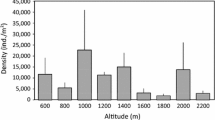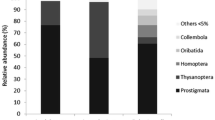Abstract
Leaf domatia are small plant structures in vein axials on the undersides of leaves that are often inhabited by mites of several species. The mites are presumed to benefit the plant because they are predatory or fungivorous. The domatia are thought to provide the mites shelter from predators and changes in relative humidity, and in exchange, the mites protect the plant from small herbivores and fungal spores. Differences in relative humidity can affect food availability, changing the interaction between plants and mites. We examined domatium morphology of the shrub Psychotria horizontalis (Rubiaceae) and its associated mite diversity at three sites along the rainfall gradient of the Isthmus of Panama, during the dry and wet seasons. The dry forest had a domatium morphology consistent with providing greater desiccation protection, with trichomes and a smaller domatium opening relative to domatium size (size/opening ratio). Additionally, this size/opening ratio was significantly higher in the dry season than in the wet season at all three sites. Mite diversity was highest at the intermediate rainfall site with a large degree of overlap with the other sites, whereas the dry site and wet site shared few mite species. More fungivorous mites were present in the moist forests and more facultative feeders on fungal spores and small mites in the dry forest. The average mite size at each site matched the average domatium size at each site. The dry forest had small mites in small domatia, whereas the moist forests had larger mites in larger domatia. While these data are primarily observational, the site and seasonal differences in domatium morphology and mite diversity are consistent with two main hypotheses: (1) that protection from changes in humidity would be particularly important when humidity was low, such as in the dry forest and during the dry season (2) more fungivorous mites would be found in domatia of the moist forests. The data presented here further highlight the close adaptive relationship between leaf domatia on plants and the mites that inhabit them.





Similar content being viewed by others
References
Agrawal AA (1997) Do leaf domatia mediate a plant-mite mutualism? An experimental test of the effects on predators and herbivores. Ecol Entomol 22:371–376
Agrawal AA, Karban R, Colfer RG (2000) How leaf domatia and induced plant resistance affect herbivores, natural enemies and plant performance. Oikos 89:70–80
Aide TM (1993) Patterns of leaf development and herbivory in a tropical understory community. Ecology 74:455–466
Castagnoli M, Simoni S (1994) The effects of different constant humidities on eggs and larvae of Amblyseius californicus (McGregor)(Acarina: Phytoseiidae). Redia 77:349–359
Croat TB (1978) Flora of Barro Colorado Island. University of Stanford Press, Stanford
Grostal P, O’Dowd DJ (1994) Plants, mites and mutualism: leaf domatia and the abundance and reproduction of mites on Viburnum tinus (Caprifoliaceae). Oecologia 97:308–315
Hutton RS, Rasmussen RA (1970) Microbiological and chemical observations in a tropical forest. In: Odum HT, Pigeon RF (eds) A tropical rain forest; a study of irradiation and ecology at El Verde, Puerto Rico. Atomic Energy Commission, Washington, DC
Kasai A, Yano S, Takafuji A (2005) Prey-predator mutualism in a tritrophic system on a camphor tree. Ecol Res 20:163–166
Lim HS, Chew FT, Mohd Dali SDB, Tan H, Lee BW, Tan TK (1998) Outdoor airborne fungal spores in Singapore. Grana 37:246–252
Nishida S, Naiki A, Nishida T (2005) Morphological variation in leaf domatia enables coexistence of antagonistic mites in Cinnamomum camphora. Can J Bot 83:93–101
Norton AP, English-Loeb G, Gadoury D, Seem RC (2000) Mycophagous mites and foliar pathogens: leaf domatia mediate tritrophic interactions in grapes. Ecology 81:490–499
Norton AP, English-Loeb G, Belden E (2001) Host plant manipulation of natural enemies: leaf domatia protect beneficial mites from insect predators. Oecologia 126:535–542
O’Dowd DJ, Pemberton RW (1997) Leaf domatia and mites in broadleaf deciduous forest in north Asia: implications for the scope of protective mutualism. Bull Ecol Soc Am 78:155
O’Dowd DJ, Willson MF (1989) Leaf domatia and mites on Australasian plants ecological and evolutionary implications. Biol J Linn Soc 37:191–236
O’Dowd DJ, Willson MF (1991) Associations between mites and leaf domatia. Trends Ecol Evol 6:179–182
Patton S (2001–2003) Environmental science program. Smithsonian Tropical Research Institute, Panama
Pemberton RW, Turner CE (1989) Occurrence of predatory and fungivorous mites in leaf domatia. Am J Bot 76:105–112
Quinn GP, Keough MJ (2002) Experimental designs and data analysis for biologists. Cambridge University Press, Cambridge
Rowles AD, O’Dowd DJ (2009) Leaf domatia and protection of a predatory mite Typhlodromus doreenae Schicha (Acari: Phytoseiidae) from drying humidity. Aust J Entomol 48:276–281
Rozario SA (1995) Association between mites and leaf domatia: evidence from Bangladesh, South Asia. J Trop Ecol 11:99–108
Walter DE, O’Dowd DJ (1992) Leaf morphology and predators effect of leaf domatia on the abundance of predatory mites Acari Phytoseiidae. Environ Entomol 21:478–484
Wharton GW, Kanungo K (1962) Some effects of temperature and relative humidity on waterbalance in female of the Spiny Rat mite, Echinolaelaps echidninus (Arcarina: Laelaptidae). Ann Entomol Soc Am 55:483–492
Acknowledgments
We would especially like to thank David Walter at the University of Alberta for mite identification, some trophic classifications and insightful discussions over the results. We gratefully thank Thomas Kursar for the use of his experimental garden plots. We would also like to acknowledge the logistical support of the Smithsonian Tropical Research Institute. We received funding from STRI and Sigma Xi (to LAR) and NSF grants DEB 0234936 and DEB-0640630 (to PDC).
Author information
Authors and Affiliations
Corresponding author
Additional information
Handling Editor: Gimme Walter.
Rights and permissions
About this article
Cite this article
Richards, L.A., Coley, P.D. Domatia morphology and mite occupancy of Psychotria horizontalis (Rubiaceae) across the Isthmus of Panama. Arthropod-Plant Interactions 6, 129–136 (2012). https://doi.org/10.1007/s11829-011-9161-4
Received:
Accepted:
Published:
Issue Date:
DOI: https://doi.org/10.1007/s11829-011-9161-4




